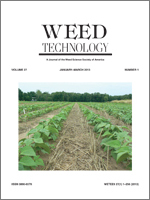In little over 20 yr, Palmer amaranth has risen from relative obscurity to its current status as one of the most widespread, troublesome, and economically damaging agronomic weeds in the southeastern U.S. Numerous factors have enabled Palmer amaranth to become such a dominant and difficult-to-control weed, including its rapid growth rate, high fecundity, genetic diversity, ability to tolerate adverse conditions, and its facility for evolving herbicide resistance. It is both a serious threat to several U.S. cropping systems and a fascinating model weed. In this paper, we review the growing body of literature on Palmer amaranth to summarize the current state of knowledge on the biology, agricultural impacts, and management of this weed, and we suggest future directions for research.
Nomenclature: Palmer amaranth, Amaranthus palmeri S. Wats. AMAPA.
En poco más de 20 años, Amaranthus palmeri ha salido de una relativa oscuridad a su estado actual como una de las malezas agrícolas más ampliamente distribuida, más problemática y económicamente dañina en el sureste de los Estados Unidos. Numerosos factores le han permitido a A. palmeri convertirse en una maleza tan dominante y difícil de controlar, incluyendo su rápida tasa de crecimiento, alta fecundidad, diversidad genética, habilidad para tolerar condiciones adversas, y su facilidad para evolucionar resistencia a herbicidas. Es una amenaza para varios sistemas de cultivos en los Estados Unidos, pero también es una maleza modelo fascinante. En este artículo, revisamos la cantidad creciente de literatura sobre A. palmeri para resumir el estado actual de conocimiento sobre la biología, impactos agrícolas, y manejo de esta maleza, y sugerimos futuras direcciones para su investigación.





